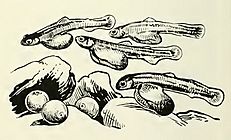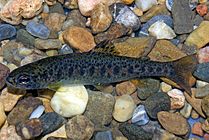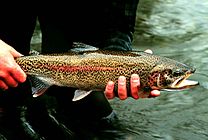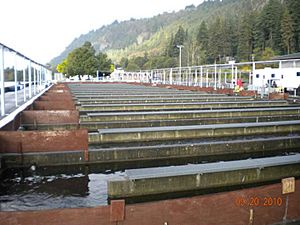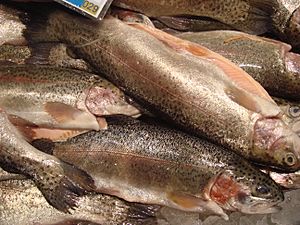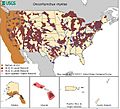Rainbow trout facts for kids
Quick facts for kids Rainbow trout |
|
|---|---|
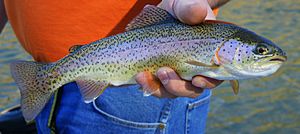 |
|
| Adult female rainbow trout | |
| Conservation status | |
| Scientific classification | |
| Genus: |
Oncorhynchus
|
| Species: |
mykiss
|
A rainbow trout is a type of fish. It is a popular fish that is raised on farms. Like all trouts, it is related to Salmon. You can find rainbow trout almost everywhere in the world. It is called a rainbow trout because its scales are often colorful and shiny, like a rainbow.
Contents
What Does a Rainbow Trout Look Like?
Adult rainbow trout that live in freshwater usually weigh between 1 and 5 pounds. Those living in lakes or the ocean can grow much larger, sometimes up to 20 pounds. Their colors and patterns can change a lot. This depends on where they live, how old they are, and if they are ready to lay eggs.
Most adult freshwater rainbow trout are blue-green or olive green. They have many black spots all over their body. They also have a wide reddish stripe along their side, from their gills to their tail. This stripe is brightest in males when they are ready to breed.
Their tail fin is mostly square and only slightly forked. Trout living in lakes or the ocean are usually more silver. Their reddish stripe might be almost completely gone.
Young rainbow trout have dark vertical bars on their sides. These are called "parr marks." Some types of rainbow trout keep these marks even when they are adults.
Sometimes, trout raised in fish farms have a small fin clipped off. This helps people tell them apart from wild trout.
Life Cycle of the Rainbow Trout
Rainbow trout, including the ocean-going type called steelhead, usually lay their eggs in spring. This happens when the water temperature reaches about 42 to 44 degrees Fahrenheit (5 to 7 degrees Celsius). A rainbow trout can live for up to 11 years.
Freshwater Life Cycle
Rainbow trout that live in freshwater usually make their homes in rivers. These rivers are often shallow, have gravel bottoms, and lots of oxygen. Lake trout like cool, deep lakes with enough shallow areas. These areas help them find food. Lake trout usually need streams nearby with gravel bottoms to lay their eggs.
When it's time to lay eggs, the female trout finds a spot in fine gravel. She uses her tail to clear a nest, called a "redd." A female rainbow trout can lay 2,000 to 3,000 eggs for every kilogram of her weight. As she lays the eggs, a male trout swims next to her. He releases sperm to fertilize the eggs. The female then covers the eggs with gravel.
The eggs usually hatch in about four to seven weeks. This time can change depending on the area. Newly hatched trout are called "sac fry" or "alevin." They have a yolk sac that provides food. After about two weeks, the yolk sac is gone. The young trout, now called "fry," start to eat tiny water creatures called zooplankton.
As the fry grow, they get dark vertical bars on their sides. These are the "parr marks." At this stage, they are often called "parr." These small young trout are sometimes called "fingerlings" because they are about the size of a human finger.
Steelhead Life Cycle
Some rainbow trout are "anadromous." This means they live in the ocean but return to freshwater to lay eggs. These ocean-going trout are known as "steelhead" in Canada and the U.S. In Tasmania, they are raised in sea cages and called "ocean trout."
Like salmon, steelhead return to the same rivers where they were born to lay their eggs. Unlike most Pacific salmon, steelhead can lay eggs more than once. They make several trips between fresh and salt water. However, less than 10 percent of wild steelhead survive to lay eggs again.
Young steelhead may stay in the river for one to three years. Then they change physically to be able to live in saltwater. This change is called "smoltification." After this, they migrate to the ocean.
Steelhead populations return from the ocean to their rivers at different times of the year.
- Summer-run steelhead leave the ocean between May and October. Their bodies are not fully ready to lay eggs yet. They mature in freshwater as they travel to their spawning grounds. They lay eggs in the spring.
- Winter-run steelhead are ready to lay eggs when they leave the ocean. This is usually between November and April. They lay eggs soon after returning to freshwater.
Once steelhead enter rivers and find good places, they lay their eggs just like freshwater rainbow trout.
What Do Rainbow Trout Eat?
Rainbow trout are predators. They eat almost anything they can catch. They are not as aggressive as some other trout types.
In freshwater, young steelhead and rainbow trout often eat insects. This includes insect larvae, pupae, and adult insects that live in the water. They also eat insect eggs and land insects that fall into the water, like ants and grasshoppers. Other foods include small fish (up to one-third of their own length), crayfish, and shrimp.
As rainbow trout grow bigger, they eat more fish. Some trout in lakes might eat tiny organisms called plankton. In rivers with other salmon, rainbow trout will eat the eggs of salmon and other trout. They also eat dead fish.
Adult steelhead in the ocean mainly eat other fish, squid, and small crustaceans called amphipods.
Where Do Rainbow Trout Live?
Rainbow trout are naturally found in the coastal waters and rivers of the Pacific Ocean basin. This area stretches from Russia's Kamchatka Peninsula, across the Aleutian Islands, through Alaska, British Columbia, and down the west coast of the U.S. to northern Mexico. Some believe the Mexican trout are the southernmost native trout or salmon.
Since 1875, rainbow trout have been introduced to many lakes and rivers around the world. Many of these introduced populations have grown and can now survive on their own in the wild.
Raising Rainbow Trout on Farms
Since the 1870s, rainbow trout have been raised in fish hatcheries. This helps restock rivers and introduce them to new waters. The first rainbow trout hatchery was set up in California in 1870.
Today, there are hundreds of hatcheries in the U.S. They are run by government agencies and tribal groups. These hatcheries raise rainbow trout for conservation and for sport fishing. Six of Canada's ten provinces also have rainbow trout farms.
Trout Farming for Food
Rainbow trout are raised on farms for food in many countries. This practice started in the late 1800s and has grown a lot since the 1950s. In 2007, over 600,000 tons of farmed rainbow trout were harvested worldwide. This was worth about $2.6 billion. Chile is the largest producer.
In the U.S., about three-quarters of farmed rainbow trout come from Idaho. This is because the water there is very good for raising trout. California and Washington also produce many farmed trout.
Rainbow trout farming is one of the biggest fish farming industries in the U.S. Trout are raised in inland facilities. These places have raceways or ponds with clean, flowing water. This reduces pollution and the risk of fish escaping. The U.S. industry is known for using good farming methods.
Rainbow trout, especially those raised on farms, can get a sickness called "enteric redmouth disease." A lot of research has been done on this disease. It is important for trout farming, but it does not affect humans.
Images for kids
-
M. cerebralis has been reported in Germany (1893), Italy (1954), USSR (1955), including Sakhalin Island (1960), U.S. (1958), Bulgaria (1960), Yugoslavia (1960), Sweden (1966), South Africa (1966), Scotland (1968), New Zealand (1971), Ecuador (1971), Norway (1971), Colombia (1972), Lebanon (1973), Ireland (1974), Spain (1981) and England (1981).
-
A large Steelhead caught on the Zymoetz (Copper) River in British Columbia
See also
 In Spanish: Trucha arcoíris para niños
In Spanish: Trucha arcoíris para niños




